Extending the Paintbrush
“Documentary should not be simply about film or art—it should have a direct
relationship with the reality that we live in every day, a direct relationship
with social work. From this it follows that one person making a documentary
film is not important; what is important is many people working together for
its sake.”
This is the Chinese independent documentary filmmaker Wu Wenguang, in his essay
“DV: Individual Filmmaking,” explaining how he understands his practice. The
epiphany came while Wu, a former high school teacher and television news station
employee-turned-documentary filmmaker, was studying with the older Japanese
documentary filmmaker Shinsuke Ogawa in 1991. The previous year Wu had finished
Bumming in Beijing: The Last Dreamers (1990), the film that would come to be widely known as China’s first
independent documentary. It is also one of the starting points of “Chinese
Realities/Documentary Visions” (“CR/DV”), the Museum of Modern Art’s
sweeping, 28-film survey of the past quarter-century of Chinese documentary
film (co-curated by MoMA Department of Film Assistant Curator Sally Berger and
Kevin B. Lee, independent curator and Vice President, Programming and Education for dGenerate Films, an American distribution company for Chinese cinema), which began last week and
will continue until June 1.
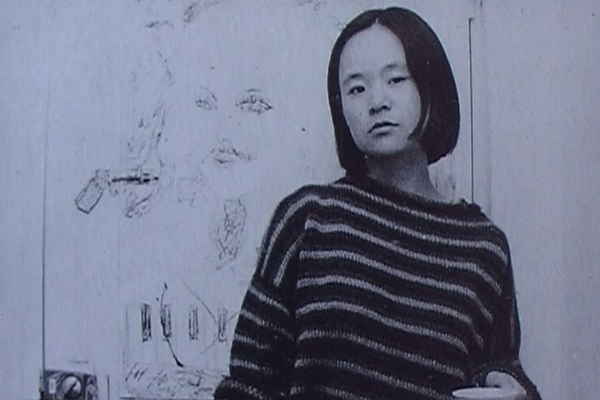
Bumming in Beijing: The Last Dreamers
In Bumming in Beijing, Wu interviews five young fellow freelance
artists who have chosen to abandon their government-assigned life paths to
pursue their crafts in the nation’s artistic capital. A theater director speaks
for the group when he says that pursuing what he enjoys was the only realistic
alternative to killing himself or living like an aimless conformist. They do
this despite knowing that a strict government can upend their homes and lives
at any time. The military massacre of civilians due to student protests at
Tiananmen Square occurred on June 4, 1989, nearly halfway through Wu’s shoot;
though none of the people in the film refer to Tiananmen by name, it’s clear
that the incident helps contribute to their increasing loss of hope in the
possibility of making a living as artists in China, leading to four of the five
of them leaving the country by film’s end.
At the time of Bumming in Beijing’s
completion, the Chinese documentary tradition essentially consisted of
state-sponsored propaganda films, the most notable subset of which were called zhuanti pian, or “special topics” films. In these programs (typically conceived for
television), a narrator recited a scripted commentary that extolled a
particular aspect of Chinese society, with stock images illustrating his points.
Bumming in Beijing’s filmmaking,
whose style came to be known as jishi
zhuyi (“on-the-spot realism”) opposed this approach. The film’s rough,
handheld images and direct, unfiltered sounds lacked voiceover as well as
musical accompaniment. Instead, they allowed for the rare occasion in Chinese
media of people sharing themselves honestly with the camera, which included
sharing their doubts and concerns about the country’s future.
The approach taken by Wu (who was present at several events during “CR/DV”’s
first days) reflected greater social change in a country opening itself to a
free market economy and greater acknowledgment of foreign voices. 1988’s River Elegy, a six-part series aired on
Central Chinese Television (CCTV), had initially assumed the appearance of a
“special topics” film encouraging Chinese citizens to embrace foreign trade
before criticizing modern China as a decaying culture burdened by the weight of
tradition. (The series was censored after the Tiananmen Square Massacre, and
its director, Xia Jun, was fired.) In the late 1980s foreign documentary crews
came to shoot in China, exposing young national filmmakers to other approaches
that went even further beyond towing the party lines.
“As China transitioned to a free-market economy, documentary film became a
means to capture how ordinary people lived and responded to their new
realities,” says “CR/DV” curator Sally Berger. This can be seen in a film like Jiang
Yue’s sweeping The Other Bank (1994),
which begins with documenting the rehearsal and performance process of a
Beijing production of a play directed by Mou Sen, one of Bumming in Beijing’s leads. (Wu Wenguang appears as a supportive
audience member.) After the play’s run ends, the film’s focus shifts to
interviewing its discarded actors, who have come from rural areas throughout
China for this work and who must now each decide whether to try to survive in
the metropolis or return home. Like Bumming
in Beijing, the film focuses on young people at a crossroads, and the
play’s central image—a distant place that one must strive to reach—comes to
take on a different meaning for each of them as they define their own paths.
Berger continues that, “Real people in real situations not only found voices in
non-fiction films, but also became part of the fabric of fiction films.” The young filmmaker Zhang Yuan, who graduated
as a member of the Sixth Generation of students to attend the Beijing Film
Academy, showed how fiction films could utilize documentary with what is now
often considered China’s first independent feature, Mama (1990). The story of a young single mother struggling to raise
her mentally challenged son, shot in Zhang’s apartment, mixed fictional elements—including
a clear, forward-moving narrative and repeated emotive close-ups of the actress
Qing Yan—with color footage of real developmentally challenged children as well
as interviews with their mothers, who discuss the need for the government to
grant their families easy access to schools as well as full legal rights and
protection. The effect of this combination is to expose the viewer to an
ongoing social problem while giving him or her a character with whom to
identify; the same holds true for the older filmmaker Zhang Yimou’s subsequent,
much larger-budget fiction film The Story
of Qiu Ju (1992), in which the star Gong Li appears as a peasant woman
within real poor Beijing neighborhoods.
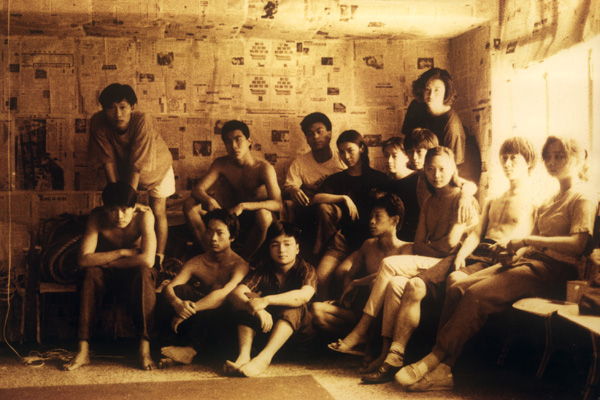
The Other Bank
Qiu Ju was released the same year that a small group of about a dozen
people met informally in Zhang Yuan’s home to discuss the emergence of what
would be called the New Documentary Movement. No manifesto was written, and no
principles were laid out save that the filmmakers would support each other in
their opposition to official media channels. The NDM’s early filmmakers
understood the system that they were opposing because many of them worked for
it—in fact, their television station jobs allowed them to easily borrow cameras
and other filmmaking equipment with which to make their independent films.
They came to see two foreign documentary filmmakers in particular as important
models for their work. The Japanese filmmaker Shinsuke Ogawa (the subject of an
upcoming New
York retrospective at Anthology Film Archives) helped create the Yamagata
International Documentary Film Festival, where many independent Chinese
documentarians received key foreign exposure. His dedication to chronicling the
struggles of peasants oppressed by the Japanese government helped inspire
Chinese films like Li Hong’s Out of
Phoenix Bridge (1997), for which the director spent two years filming
migrant women looking for work in Beijing. (The film in fact won Yamagata’s
Shinsuke Ogawa Award, given to emerging Asian filmmakers, a few years after Wu
Wenguang had won the prize for his film My
Time with the Red Guards [1993, not included in “CR/DV”].)
The other influential foreign artist was the American documentarian Frederick
Wiseman, whose films study the mechanics of institutions ranging from military
complexes to mental institutions to high schools and avoid voiceover,
soundtracks, and on-camera interviews in favor of observing authority figures
as they make fools of themselves in action. Wiseman was such an important
influence that Wu Wenguang (who had since made a sequel to Bumming in Beijing, consisting of new encounters with its leads,
called At Home in the World [1995]) brought him to China, where he
organized a screening series and met NDM filmmakers. It’s easy to see Wiseman’s
influence in a film like Duan Jinchuan’s No.
16 Barkhor South Street (1996), a TV-sponsored record of a national
ceremony celebrating the anniversary of China’s 1951 declaration of sovereignty
over the current “autonomous entity” of Tibet, or what has often
been called Tibet’s liberation. As the film proceeds, Chinese officials
order Tibetan civilians to wear clothes identifying themselves, and tell them
that they will not be able to go to the bathroom during this event that they
have been required to attend. The film’s careful observation, made by a Chinese
filmmaker who had lived in Tibet for eight years prior to filming, makes clear
the problems inherent in calling Tibet liberated without delivering an explicit
message about them. “It proved a valuable approach to a situation where so
little could be said publicly,” says Robert Barnett, Director of the Modern
Tibetan Studies Program at Columbia University. “Duan made a commitment to
really look at what he could actually see in Tibet, rather than fulfill
peoples’ desires for what they want to see there.”
Though “CR/DV,” as well as this article’s historical summary, has omitted many
key films and filmmakers from the NDM, the narrative of Chinese independent
documentary can still be summarized as that of a small, little-known group of
collaborators based in Beijing. But soon, as series co-curator Kevin B. Lee says,
“The technology proliferated beyond the professionals.” In 1997 the small,
light mini DV (digital video) camera debuted in China, leading to what the
great documentary and fiction filmmaker Jia Zhangke (represented in “CR/DV” with
his hybrid film 24 City [2008]) has
since called “the age of the amateur.” Shooting on mini DV proved significantly
cheaper, faster, and simpler than working with celluloid cameras had been and
as a result, many more people were able to make films with much greater
facility than had previously been the case. In a 2002 questionnaire,
the filmmaker Ning Ying wrote simply, “dv allows for more freedom.”
The new technology left greater room for documentary artists to be able to make
films outside Beijing. The monumental Tie
Xi Qu: West of the Tracks (2003) is one such example of a film whose
creation was facilitated by mini DV’s advent. The film's television-trained director, Wang Bing (whose marvelous recent film Three Sisters is currently playing in a weeklong theatrical run at Anthology Film Archives), and his sound engineer Lin Xudong spent two years filming in the Tie Xi factory district. Wang was thus able to record many of the
metallurgical and smelting factories, originally built by Japanese imperialists
in the 1930s, as they fell into disrepair, abandoned by bankrupt owners. He was
also able to record their workers being discarded. The finished film consists
of three parts, shot roughly simultaneously, that focus on the remaining active
factory environments, which are male-dominated (most of the female workers have
been fired), the district neighborhoods whose residents are being forced out of
their homes, and the railway system running throughout the area. Though the
people onscreen rarely acknowledge Wang, his proximity to them is always felt.
A recurring type of shot throughout the film positions the camera at the front
of a train, looking forward through the snowy tracks, as though eager to
capture the district while it still exists.
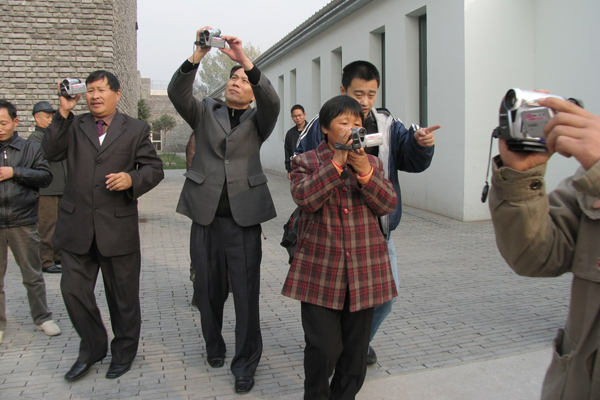
Chinese Villagers Documentary Project
West of the Tracks subtly indicates how the switch from film to mini DV
cameras created not just a technical shift but an existential one. The
filmmaker could no longer behave like an observer, as the amount of time and
equipment involved in working with celluloid could allow him, but would now
have to explicitly be a part of the action. The degree of active participation
in the action could vary—in Railroad of
Hope (2002), the filmmaker Ning Ying’s voice is heard onboard a train as
she talks with migrant workers seeking employment—but the choice to actively
participate could not.
In Wu Wenguang’s 2001 essay “DV: Individual Filmmaking” (published in an
English-language translation by Cathryn Clayton in 2006), Wu wrote about the
changes that he felt himself undergoing while recording a traveling performance
troupe with a mini DV camera for his film Jiang
Hu: Life on the Road (1999). “With this project,” he wrote, “I just carried
the DV camera with me like a pen and hung out with the members of the troupe.” He
would turn the camera on and off as he chose to, taking it with him into
people’s homes and even using it while cooking. Up to then, making
documentaries had not been “such a casual, individual thing”; now the
separations between filmmaker and subject, and between life and art, only
existed to the extents to which he wished to impose them. As a result, he
claimed, he became more connected to and invested in his subjects than he had
ever been before. Rather than being a filmmaker, “I have become an individual
with a DV camera…it was DV that saved me, that allowed me to maintain a kind of
personal relationship to documentary filmmaking, and made it far more than just
an identity.”
The extent of Wu’s presence in the celluloid works he had made up to that point
had varied. In Bumming in Beijing,
his voice can be heard offscreen as he addresses his fellow freelance artists;
at other times he can be seen in front of the camera. At all times he was
included as a character within the action. Yet with video he would not just
include himself within the story, but criticize his place in it. A young man from
a rural part of the Eastern Chinese province of Shangdong with the stage name
Wang Zhutian brought Wu an autobiographical script for a fiction film that he
wanted the director to shoot; Wu demurred, and instead filmed the young man as
he took the script to a Chinese mainstream film production executive, who told
him that it would need to be less personal and include more sex.
Resulting scenes show members of the film industry (including Mama director Zhang Yuan) speaking
condescendingly to the young man and to other people from poor, rural
backgrounds who are trying to break into the industry while happily greeting the
cameraman Wu as one of them; these scenes also show Wu letting the imbalance
stand for the sake of his own movie. Wu stays silent in response both to
colleagues cajoling him and to Wang begging him for help, and in both cases his
silence is damning. Wu struggled to find a title for his film until attending
the Tokyo International Film Festival. After hearing filmmakers who had been
snubbed for prizes complain—“Fuck the jury,” “Fuck the festival”—he chose to
title it Fuck Cinema (2005).
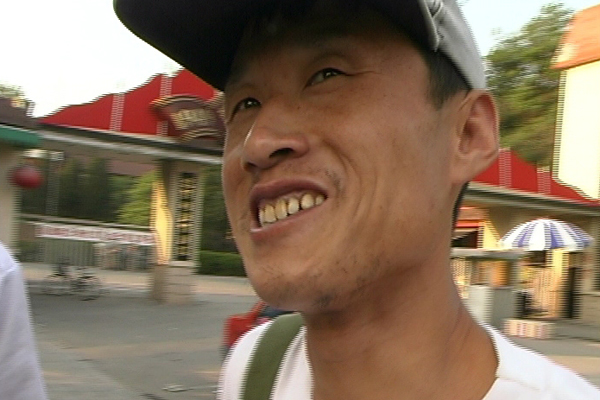
Fuck Cinema
At one point in the film, a man laughs at Wu’s camera and says, “I see you came
armed”; in another moment, Wang says that he feels as though Wu’s camera is
being pointed at him like a gun. Fuck
Cinema suggests that a great imbalance of power exists between the person
filming and the people being filmed. The parties have to actively work together
if they wish to hold equal control over what is being depicted. Independent filmmaker
Jian Yi felt the same way. In 2004 Jian was working as a public communications
expert for a European Commission initiative called the EU-China Training
Programme on Village Governance. Part of his work consisted of training
residents of small villages throughout China how to conduct an election. But he
felt compromised in his efforts to communicate with civilians directly; as Jian
writes by e-mail, “I found myself talking with villagers while ten escorts from
various levels of the local government surrounded me.”
For the sake of getting alternative perspectives on village life, he soon
afterwards invited Wu Wenguang to judge a national photo contest on village
governance. The two men received a set of submissions shot almost entirely by
professional photographers, to which Wu responded by suggesting that they
engage villagers in telling their own stories.
A nationwide application process resulted in the selection of 10 villagers from
different parts of China, each of whom made a short documentary about his or
her hometown’s electoral processes that were eventually combined into the omnibus
film China Villagers Documentary Project (2005).
Each segment begins with a brief introduction to the filmmaker, who can belong
to either gender and many different age groups. (The youngest filmmakers are in
their early twenties, the oldest in their late fifties.) This introduction is followed
by a brief chronicle of fellow villagers arguing over how to run elections
best. Like in comic novels, the stated end goal is rarely reached. The things
that consistently come to matter in the short films are not who wins the
elections, but other aspects of self-governance, such as the pleasure of voting
for the first time. Some segments diverge from voting preparations altogether
for more pressing business, such as debates over how large to build a village’s
lake.
In the film’s second segment, a group of children point at the camera and
shout, “Monster! This is a monster from another world!”, a comic reflection on Wu’s
problems with his own filmmaking. Since then, Wu has shepherded amateur
filmmakers through training at his Caochangdi Workstation in Beijing and
through programs such as his Folk Memory Documentary Project, in which people
record their villages’ histories, sometimes for more than one film. Zou
Xueping’s The Starving Village (2010)
captured the recollections from members of her village of The Great Famine
(1958-1961), a period during Mao’s Great Leap Forward in which anywhere between
15 million and 45 million people starved to death. In Zou’s follow-up film, The Satiated Village (2011), the
filmmaker returns to show The Starving
Village to the film’s subjects and record their reactions to it, including
their concerns over whether showing the film abroad would do harm to China.
Wu’s brand of participatory documentary is one particular strand of
observational films unfolding in recent Chinese independent documentaries. Others
are overtly political in observing people and places that might never be
registered on film otherwise. American filmmaker
and anthropologist J.P. Sniadecki, present at "Chinese
Realities/Documentary Visions" with his experimental portrait of an
oil-rich site-turned-ghost town, Yumen (co-directed with Chinese filmmakers Huang Xiang and Xu Ruotao), writes by
e-mail that "one of the stark differences between the creative communities
I've been involved with in the United States and in China, of course, is the
political climate, and how government pressure and repression work to shape
and, contrary to the government's intention, even fuel the production of the
independent documentaries in China today.”
An example of a political film demonstrating compassion towards others is Zhao
Liang’s Petition (2009), filmed over
12 years as people from throughout China camp out near Beijing petition offices
to demand that the government address their grievances. A viewer senses that
the filmmaker cannot help but become emotionally invested in his subjects as he
films them. Other films, such as Tape (2010),
are more directly pointed towards self-observation from the outset, as the
performance artist Li Ning (who has previously collaborated with Wu Wenguang) assembles
disorderly fragments from throughout his professional and personal life in
order to comment on his struggles to survive as an artist. Hu Jie’s Though I Am Gone (2007) suggests how
both a filmmaker and his or her subject always hold responsibility to each
other. The black-and-white film consists mainly of an interview with Wang
Qingyao, an 85 year-old former teacher whose wife was a high school vice
principal beaten to death by her students during the Cultural Revolution. Wang photographed
her corpse and now presents the images to Hu because, he says, “If I do not
tell the true story, I would be ashamed of not doing my duty.” He is also
speaking for the filmmaker.
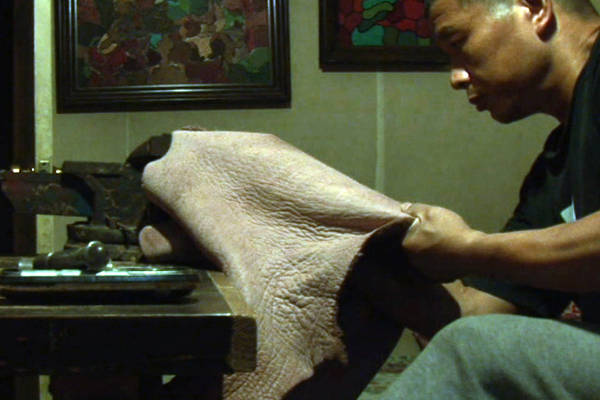
Oxhide II
These films’ humanist approaches are just a few examples of the kind of work
that’s being done, as are more formally experimental documentaries like the
structural work Oxhide II (2009) and
the found footage film Disorder (2009).
Karin Chien, President/Founder of dGenerate Films, says that for her the filmmaking
in contemporary Chinese independent documentaries—whether the films are being
made for personal, political, or aesthetic reasons—is “basically an extension
of the pen or the paintbrush.” She sees the films as tending “to draw towards
things that are not covered in the mainstream media, specifically because they
are not being covered there. While in the United States documentaries often
exist to give another side of an issue that’s being discussed, in China there
is often simply no discussion.”
One can see this emphasis on acknowledging hidden subjects—in a country where film
festivals live at risk of government closure, and where outright criticism
of the one-party system can still land an artist in prison—continuing not just
through pure documentaries, but also through fiction films with documentary
elements. Pema Tseden’s Old Dog (2011),
which will receive a weeklong run during “CR/DV” with the filmmaker in person, tells
the story of a Tibetan family arguing over whether to sell its prized mastiff
to Chinese buyers before the animal can be stolen. The state-sponsored Old Dog functions like early independent
Chinese fiction films did by recording actors in the interest of revealing a
setting. This time, the setting is Tibet under Chinese rule, as shown by the
first director in China to film in the Tibetan language with an all-Tibetan
crew. “This film is trying to find a language that gives us the comforts of
fictional storytelling while encouraging us to search for other levels of
meaning,” says Robert Barnett, in reference to the way the film allegorizes contemporary
challenges facing Tibetan culture.
Yet even despite all these different trends and examples, it’s still hard to
generalize about what’s happening in Chinese independent documentary film
today. This is not just because there’s so much product—in feature-length films
as well as the many videos uploaded onto the Chinese YouTube, tudou.com—but
also because so little of it is being seen in China or in the States. The bulk
of these films never achieve theatrical distribution in either country, instead
reaching audiences through DVDs and online links. What is clear is that a
widening number of approaches are available to independent Chinese filmmakers,
many of whom are making deeply personal work in dialogue with each
other’s.
Ying Liang’s When Night Falls (2012)
is a fiction film based on a true story, and even largely inspired by two
previous documentaries—One Recluse (2010),
an investigation into the case of a young man, Yang Jia, executed in 2008 for
murdering four policemen after he had beaten and his claims of police abuse
ignored, and Wang Jinmei (2010), a
filmed interview with the young man’s mother. Both of these documentaries were
directed by the visual artist and political activist Ai Weiwei, who has
made a practice of posting his films online despite the Chinese
government’s efforts to either firewall them or take them down altogether.
(Ai’s record of his own extreme struggles with Chinese police, Disturbing
the Peace [2010], is featured
in the “CR/DV” lineup.)
Ying’s film uses a professional actress (Nai An) to imagine how Wang Jinmei
might have behaved on the day that her son was executed (an event that she did
not learn about until after it happened), while bookending its reimagining with
photographs and tweets that the real woman had posted online. Ying has told me
that in real life the case’s proceedings were closed to the public, and that information
about Wang Jinmei had been difficult to find. He told this story as a way of
helping people identify with someone that he considers to be an ordinary woman
in extreme circumstances. Ying writes by e-mail that “Life is wider than cinema
is for me.”
Many of the films discussed in this
article can be found and viewed online. More information about recent Chinese
independent documentary can be read in the book The New Chinese Documentary
Film Movement: For the Public Record (2010),
edited by Chris Berry, Lu Xinyu, and Lisa Rofel. The book includes a reprint of
Wu Wenguang’s essay “DV: Individual Filmmaking.”
Thanks for additional research help to Robert Barnett, Sally Berger, Chris
Berry, La Frances Hui, Jian Yi, Kevin B. Lee, J.P. Sniadecki, Wai Ho, Zhu
Rikun, and Karin Chien and dGenerate Films.
Aaron Cutler lives with the artist
Mariana Shellard, works as a programming aide for the São Paulo
International Film Festival, and
keeps a film criticism site, The Moviegoer.
![]()
LATEST ARTICLES
-20140814-173707-thumb3.jpg)
Fighting Words
by Imogen Sara Smith
posted August 12, 2014

Fighting Words, Part 2
by Imogen Sara Smith
posted August 20, 2014

On the Margins: The Fil…
by Andrew Chan
posted August 12, 2014

Robin Williams: A Sense…
by David Schwartz
posted August 12, 2014
 Extending the Paintbrush
Extending the Paintbrush
KEYWORDS
Chinese documentary cinema | Wu Wenguang | Bumming in Beijing | Chinese Realities/Documentary Visions | The Other Bank | Chinese Villagers Documentary Project | Fuck Cinema | Oxhide II | Zhang YuanTHE AUTHOR
Aaron Cutler is a writer in São Paulo. His film writings can be found at http://aaroncutler.tumblr.com.
More articles by Aaron Cutler
